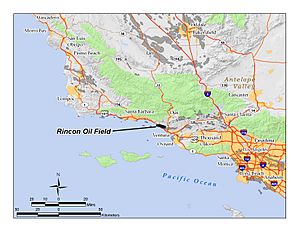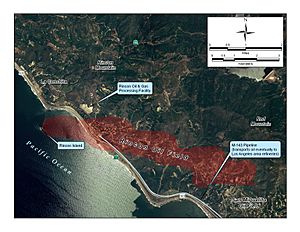Rincon Oil Field facts for kids
The Rincon Oil Field is a large area on the coast of southern California where oil is found deep underground. It's located about 10 miles (16 km) northwest of Ventura and 20 miles (32 km) east-southeast of Santa Barbara. This oil field is the westernmost one in a line of three fields that follow a special underground fold called the Ventura Anticline.
Oil was first discovered here in 1927. The Rincon Oil Field is the 36th largest in California based on how much oil can be taken out. Most of its oil has already been used, with only about 2.5% remaining from its original amount. However, it was still producing oil with 77 active wells in early 2008. The oil from this field travels through a pipeline called M-143, which goes to refineries near Los Angeles. As of 2009, Occidental Petroleum managed the part of the field on land, and Greka Energy managed the part under the ocean, mostly from Rincon Island.
Contents
Where is the Rincon Oil Field Located?
The Rincon Oil Field is found in a region of steep hills near the Santa Ynez Mountains. Some of these hills, like Rincon Mountain and Red Mountain, reach over 2,100 feet (640 meters) high. Highway 101 runs along a narrow strip of land at the bottom of these hills, right next to the Pacific Ocean.
Water from rain flows down small streams directly into the ocean. This area can have many landslides, especially during very rainy winters. For example, in 2005, a nearby town called La Conchita had a serious landslide.
The plants that naturally grow here include coastal sage scrub and chaparral. The weather is Mediterranean, meaning it has cool, rainy winters and mild summers. Morning fog and clouds help keep the summers from getting too hot. About 15 inches (38 cm) of rain falls each year, with a bit more in the higher parts of the hills.
How Oil is Processed Near Rincon
The Rincon Oil and Gas Processing Facility is located on a flat hilltop about a mile east of Pitas Point. This facility doesn't process oil from the Rincon field itself. Instead, it handles oil from other offshore fields, like Dos Cuadras and Carpinteria. This oil then goes into the M-143 pipeline, which passes through the Rincon field on its way to Ventura. There's a very large tank at the plant, holding 268,000 barrels of oil from the Rincon field before it's sent through the pipeline.
Rincon Island: An Artificial Island
The part of the oil field under the ocean is mostly in shallow water. Workers reach this area using Rincon Island, which is an artificial island. It's about two-thirds of a mile (1.1 km) south of Punta Gorda. A 3,000-foot (910 m) long causeway, which is like a narrow bridge, connects the island to the mainland. This causeway is too narrow for regular cars, but it holds pipelines that carry oil, water, and natural gas back to the shore for processing.
Understanding Rincon Oil Field's Geology
The Rincon field sits at the western end of the Ventura Anticline. Imagine this anticline as a long, narrow, upside-down "V" shape, like the roof of a house. Oil and gas get trapped in the rock layers under this fold. Two other oil fields on land, the San Miguelito field and the huge Ventura Oil Field, also follow this anticline further to the southeast.
West of Rincon, the anticline continues under the ocean. It includes the Carpinteria offshore field and the Dos Cuadras field. The Dos Cuadras field was the source of a well-known oil spill in 1969. The land around the Rincon field is known for being very prone to landslides. Much of the surface is made of loose soil and rock from past landslides.
Where the Oil is Found Underground
All the oil in the Rincon field is found in a thick layer of rock called the Pico Formation. This rock layer formed in a shallow ocean between 5.3 and 1.6 million years ago, during a time called the Pliocene epoch. The Pico Formation contains sandstones, siltstones, and conglomerates. These rocks have tiny spaces that can hold a lot of oil when they are folded into an anticline.
The field is divided into three main parts: the Main Area, Oak Grove, and Padre Canyon. Each part has several layers of rock where oil is found, all within the Pico Formation. These oil-rich layers are at different depths, from about 3,400 feet (1,036 meters) deep in the western Main Area to about 13,000 feet (3,962 meters) deep in the Oak Grove Area. The oil found here is considered "medium-grade."
History of Rincon Oil Field Operations
The Rincon field was discovered in December 1927. This was during a time when many of California's biggest oil fields were being found. The Pan American Petroleum Company drilled the first successful well, called Hobson Fee No. 3. They drilled down 2,557 feet (779 meters) and found oil under high pressure.
Over the next few years, more oil was discovered. While these discoveries weren't huge gushers, they were profitable enough to encourage more drilling. In 1928, the "Miley" oil layer was found. Deeper oil zones in the main area were discovered in 1929, with the deepest at 7,800 feet (2,377 meters). Chanslor-Canfield Midway Oil Co. found the Oak Grove Area in 1931, and Continental Oil Co. discovered the Padre Canyon area in 1936. It took another 30 years to find the deeper oil zones in these areas.
How Oil Production Changed Over Time
To get more oil out of the ground, a method called waterflooding began in 1961. This involves injecting water into the oil-bearing rocks to push the oil towards the wells. By the end of the 1960s, most parts of the field were using waterflooding.
The Rincon field produced the most oil in 1972, with over 4.6 million barrels that year. This was a bit unusual for California oil fields, which often reached their peak production shortly after discovery. The second peak in Rincon's production happened after new technologies like waterflooding were developed in the 1960s.
Companies Operating the Field
In 1993, a company called Vintage Petroleum bought the Rincon and nearby San Miguelito oil fields from other companies like Mobil and Conoco. Vintage combined the two fields to make operations more efficient. Later, in 2006, Occidental Petroleum bought Vintage Petroleum. Occidental still operates the onshore part of the field today under the Vintage name.
In 2002, Greka Energy took over Rincon Island and a small area of operations on land near Highway 101. This onshore area has wells that drill sideways into the offshore oil formations. Greka continues to operate these facilities.






